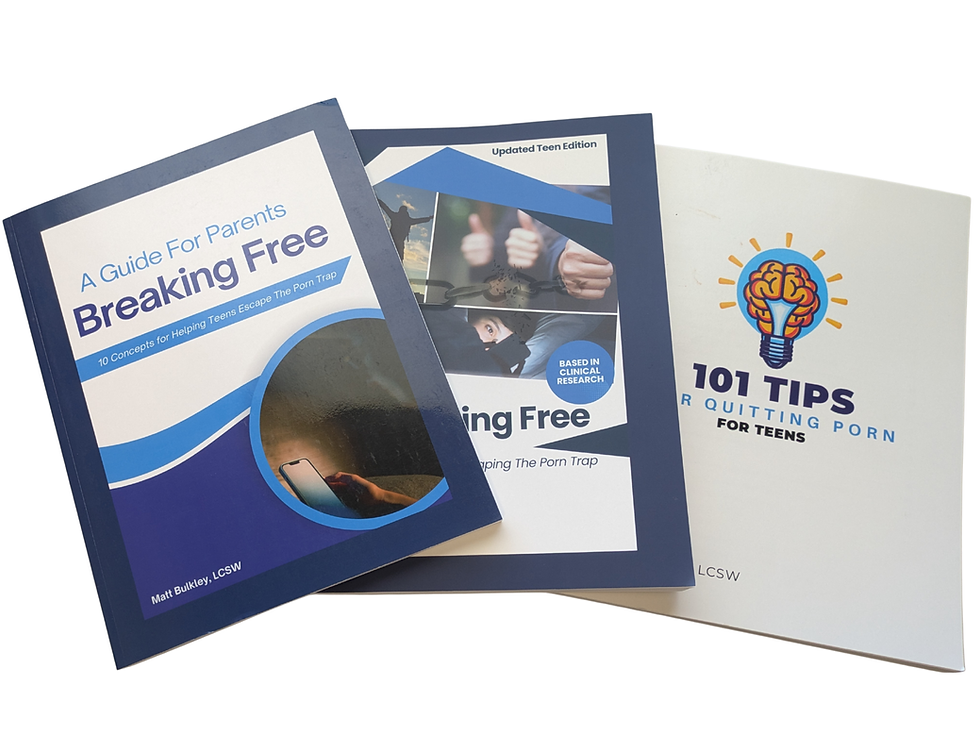Should Your Teen Have a Phone After a Pornography Addiction? A Guide for Parents
- Matt Bulkley

- Sep 2
- 4 min read
Discovering your teen’s struggle with pornography addiction is a heavy moment. As a parent, you’re likely wrestling with how to support their recovery while navigating the role of technology in their life. One pressing question is whether your teen should have a phone—and if so, should it be a smartphone or a basic phone like a Bark Phone or “dumb phone”? This decision can significantly impact their recovery journey. Let’s break down the pros, cons, and practical recommendations to help you make an informed choice.
The Role of Phones in Your Teen’s Life
Phones are a central part of modern life, especially for teens. They’re tools for communication, learning, and social connection, but they can also be gateways to harmful content. For a teen recovering from pornography addiction, a phone can either support their progress or pose serious risks. Understanding both sides is key to deciding what’s best for your teen.
Pros of Allowing Your Teen to Have a Phone
Connectivity and Support Networks
Phones keep teens connected to family, friends, and support systems, like mentors or recovery groups. Positive relationships are a protective factor against addiction, according to a 2019 study in Developmental Psychology. A phone can help your teen reach out for support during tough moments, reinforcing healthy connections.
Learning Responsibility
Allowing limited, monitored phone access can teach your teen to use technology responsibly. By setting clear boundaries and consequences, you’re helping them build self-discipline, a critical skill for recovery.
Access to Recovery Resources
Smartphones can provide access to apps and tools that support recovery, such as mindfulness exercises, journaling apps, or online support communities. These resources can empower your teen to stay focused on their goals.
Cons and Risks of Phone Access
Easy Access to Explicit Content
Smartphones, with their internet browsers and apps, make it easy to stumble across or seek out pornography. A 2020 study in Cyberpsychology, Behavior, and Social Networking found that unrestricted internet access significantly increases exposure to explicit content, raising the risk of relapse for teens in recovery.
Bypassing Parental Controls
Many teens are tech-savvy and may find ways to circumvent parental controls or filters. This can undermine your efforts to create a safe digital environment, making smartphones a risky choice without strict oversight.
Addiction Triggers
Smartphones are designed to keep users engaged with constant notifications, social media, and apps. These features can trigger compulsive behaviors, pulling your teen back into harmful habits and derailing their recovery.
Smartphones vs. Basic Phones: What’s the Difference?
Smartphones: These offer internet access, apps, and endless content. While they’re versatile for school or social needs, they also provide easy access to pornography, even with parental controls in place.
Basic Phones (e.g., Bark Phone or “Dumb Phones”): These devices typically offer only calling and texting, with no or limited internet access. They reduce temptation while still allowing essential communication. The Bark Phone, for example, includes built-in monitoring features to track texts and calls, offering parents peace of mind.
Recommendations for Parents
Given the risks, erring on the side of caution is wise, especially early in recovery. Here’s a step-by-step approach to consider:
Start with a Basic Phone
A basic phone, like a Bark Phone or a traditional “dumb phone,” is often the safest choice. These devices limit internet access, significantly reducing the risk of exposure to explicit content while still allowing your teen to stay connected for emergencies or family communication. This approach prioritizes recovery without isolating your teen.
Use a Smartphone with Strict Safeguards (If Necessary)
If a smartphone is required for school or other essential activities, implement robust safeguards:
Parental Controls: Tools like Bark, Qustodio, or Apple’s Screen Time can block explicit content, limit app usage, and monitor activity.
Accountability Software: Programs like Covenant Eyes track browsing history and share reports with a trusted accountability partner (e.g., a parent or mentor), encouraging transparency.
Regular Check-Ins: Review the phone’s activity together to reinforce accountability and build trust.
Frame the Decision as Support, Not Punishment
Talk openly with your teen about why you’re choosing a basic phone or adding restrictions to a smartphone. Explain that these measures are about creating a safe environment for their recovery, not about distrust or punishment. Involve them in the decision-making process to foster ownership and cooperation.
Monitor and Adjust Over Time
Recovery is a journey, and your teen’s needs may change. Start with stricter limits and gradually reintroduce smartphone privileges as they demonstrate responsibility and progress. Regular conversations about their feelings, triggers, and goals can guide your approach.
Additional Tips for Supporting Recovery
Set Clear Boundaries: Agree on phone usage rules, such as no phones in private spaces like bedrooms or bathrooms, where temptation may be higher.
Encourage Offline Activities: Promote hobbies, sports, or volunteering to fill the time previously spent on harmful habits.
Seek Professional Support: A counselor or therapist specializing in addiction can provide tailored strategies for your teen’s recovery.
Model Healthy Tech Use: Show your teen how to use technology mindfully by setting your own boundaries, like limiting screen time or avoiding phones during family moments.
Final Thoughts
Deciding whether your teen should have a phone after a pornography addiction requires balancing their need for connection with the risks of relapse. A basic phone, like a Bark Phone or “dumb phone,” is often the safest starting point, minimizing temptation while maintaining essential communication. If a smartphone is necessary, pair it with robust parental controls and accountability tools like Covenant Eyes to create a safer digital space. Above all, approach this decision with empathy, open communication, and a focus on your teen’s long-term recovery. By working together, you can help them rebuild healthy habits and navigate technology responsibly.










Comments